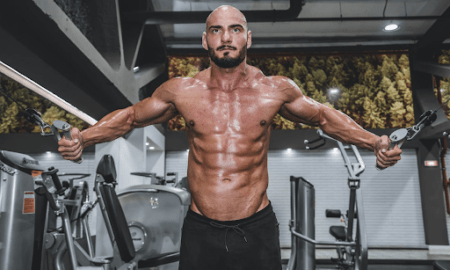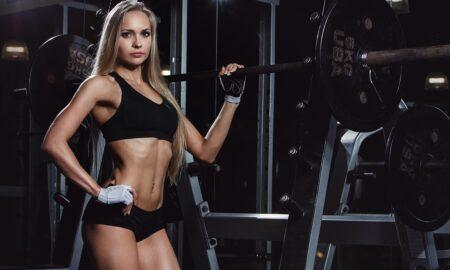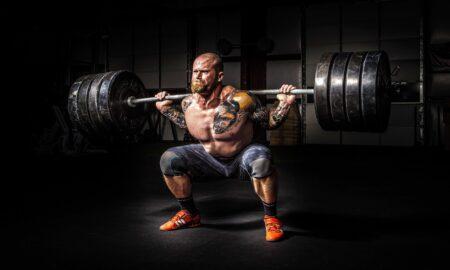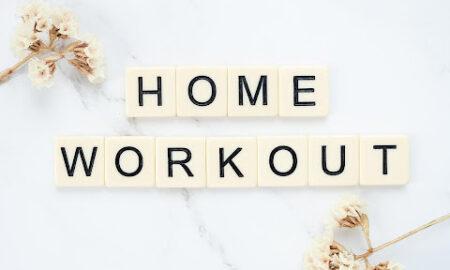Q: I’m a 36-year-old aspiring bodybuilder, and I have a couple of questions. I’m very new to thinking about a more bodybuilding-oriented approach to my workouts. About 4 1/2 years ago I was almost 400 pounds with a 59-inch waist—with all of the tremendous health concerns that go with it. After changing my diet and starting a weight-training and cardio program—and doing the basics that have been preached for decades but that I never thought would work for me—I dropped 180 pounds and my waist is down to 32. My bodyfat fell from well over 50 percent—best guess since most measuring tools were useless—to 15 percent. I thought I still had a long way to go until several amateur and one female pro bodybuilder encouraged me to change to a bodybuilding-oriented workout. What type of routines would be helpful for me to put on mass at my age and with my history? Also, should I be concerned about me going on a more traditional bulking diet because of my long history of being fat? I know I have to eat to grow, but I am petrified of getting fat again. Are there supplements or particular food groups to add, look out for or avoid altogether?
A: Wow, talk about a success story! Congratulations on your incredible transformation. Losing almost 200 pounds of bodyweight and 27 inches off of your waist is really something to be proud of.
It’s great that you want to get more into the bodybuilding lifestyle and continue to improve your physique. From what I see of the success stories on TV shows like “The Biggest Loser,” many of those individuals gain all or most of their weight back after the cameras go away and they return to their previous lifestyles.
By setting up more aggressive goals for yourself, you will not only not gain the weight back but also continue to improve on your physique and be a real success story. That’s the key for everyone who is involved in fitness—you have to keep setting new goals for yourself in order to stay motivated and continue to improve.
I’m not sure what type of training routine you were using when you were losing the weight, but you said it was a basic one. It sounds as if you’re looking for a more advanced routine that will help you to build more muscle now that you have lost most of your bodyfat.
You can begin by doing a split routine, training each muscle group twice a week. That will enable you to train each muscle group more extensively by using more exercises and volume. It’s a much better routine for adding muscle mass than the one you used to lose the fat and get in shape.
The intermediate split routine will have you train half of your muscle groups at one workout and the others at the next. It’s important to arrange the muscle groups so you don’t overtrain them by working a related muscle two days in a row.
For example, if you train shoulders on the first training day and chest on the following day, your chest workout may be compromised from the shoulder workout you did the day before. Chest exercises like bench presses, incline presses and dips all involve the front deltoids. If they are sore or tired from being trained the day before, they will be a weak link when you train your chest and you will not be able to get the full benefit from your chest workout.
That’s why it’s a good idea to train the bigger muscle groups on the first day and the smaller groups the following day. One routine that I like trains the chest, back and shoulders at the first workout and legs and arms at the second.
The chest, back and shoulders are all closely connected because the front delts are involved in many chest exercises and the rear delts are worked during most back exercises. Because you train those two major muscle groups first, your delts will be warmed up and ready for a workout.
The next day you can train your legs. Because they are the biggest and most powerful muscle group in the body, they are a very difficult group to train and they require a lot of energy to work them properly. It would be a mistake to work another big muscle group, like the chest or back, in the same session as legs.
Training legs and arms together is much more logical because the arms are a relatively small bodypart and don’t require as much energy. Plus, by training your arms the day after you do chest, back and shoulders instead of the day before, you won’t ruin the workouts for those bigger muscle groups.
With this split you can use two or three exercises for each muscle group. That would not be possible with a basic routine in which you train the whole body in one workout. Splitting up the workouts enables you to train each muscle more extensively, which will give you more complete development in each bodypart as well as size.
Here’s a good split routine that you can start off with. It involves four workouts a week, training each muscle group twice a week.
Monday and Thursday
Barbell bench presses 3 x 10, 8, 6
Incline dumbbell presses 3 x 8, 8, 6
Wide-grip pulldowns 3 x 10, 8, 6
One-arm dumbbell rows 3 x 8, 8, 6
Hyperextensions 3 x 15
Seated dumbbell presses 3 x 10, 8, 6
Upright rows 3 x 10, 8, 8
Seated calf raises 3 x 15-20
Standing calf raises 3 x 12, 10, 8
Tuesday and Friday
Hanging knee raises 3 x 20-30
Crunches 3 x 30-40
Squats 3 x 10, 8, 6
Leg presses 3 x 12, 10, 8
Leg curls 3 x 10, 8, 8
Stiff-legged deadlifts 3 x 10, 8, 6
Pushdowns 3 x 10, 8, 8
Lying extensions 3 x 10, 8, 6
Seated dumbbell curls 3 x 10, 8, 8
Barbell curls 3 x 8, 8, 6
You also asked about your diet because you are concerned about adding fat during the bulking-up phase. My advice is not to bulk up at all. You can add muscle mass without eating an excess of calories that will probably cause you to gain fat.
Bulking up is great for those who have a very fast metabolism and find it almost impossible to gain muscle size through conventional methods. Teenagers can really benefit from bulking up because the extra calories allow their metabolism to slow down so they can finally start adding muscle. Eating a normal bodybuilding diet will probably not give them the results they want if they have a superfast metabolism.
In your case you can add muscle by eating enough calories to feed the growth process without eating an excessive amount that would cause you to add fat. Keeping close track of what you eat everyday is a great way to make sure you’re gaining muscle but not add excess fat.
I recommend you begin by eating a little more than one gram of protein for each pound of bodyweight. At 220 pounds you should start with 250 grams of protein each day spread over six meals. Choose complete protein foods like egg whites, fish, chicken breasts, turkey, round steak and salmon for your protein sources.
You should also eat enough complex carbohydrates to provide the glycogen you need for your workouts as well as your recovery after your training sessions. The carbs will be a great help to your muscle-building efforts. Many people make the mistake of limiting their carbs when trying to get bigger. The key is to eat the right kind of carbohydrates and eat them at the right times.
Focus on eating complex carbs that are high in fiber and are low glycemic—meaning they don’t cause a big spike in your blood sugar. Carbohydrates like oatmeal, brown rice, quinoa, sweet potatoes, Ezekiel bread and oat bran as well as green, fibrous vegetables like broccoli, asparagus and green beans are great additions to your mass-building diet.
I recommend you get about one gram of carbohydrate for each pound of bodyweight. That should give you the glycogen and energy you need for your workouts and muscle growth. Shoot for 200 to 220 grams of carb to start, and see if that works for adding muscle while staying lean.
As for fats, keep them moderate by concentrating on the essential fatty acids like the omega-3 fats. Take one to two tablespoons of flaxseed oil—I like adding it to my protein drinks—as well as salmon. I try to eat salmon three times per week.
You will also get some saturated fats when you eat egg yolks, turkey and steak. That’s fine as long as you don’t overdo it. Aim to keep your fat intake around 50 to 60 grams, with most of it coming from the essential fatty acids.
Editor’s note: John Hansen has won the Mr. Natural Olympia and is a two-time Natural Mr. Universe winner. Check out his Web site at www.NaturalOlympia.com, or send questions or comments to [email protected] or at P.O. Box 320264, Tampa, FL 33679. Look for John’s DVD, “Natural Bodybuilding Seminar and Competitions,” along with his book, Natural Bodybuilding, and his training DVD, “Real Muscle,” at his Web site or at Home Gym Warehouse, www.Home-Gym.com. Listen to John’s new radio show, “Natural Bodybuilding Radio,” at www.NaturalBodybuildingRadio.com. IM




















You must be logged in to post a comment Login